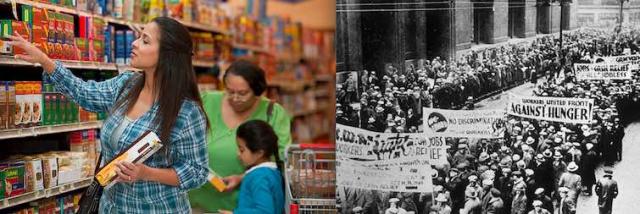What a truly horrific idea President Trump has come up with in calling for an end to the provision of food assistance money under the Supplemental Nutrition Assistance Program (SNAP), which he’d supposedly like to turn into a “surplus food” type operation where people are provided with canned goods and other packaged foods instead of cash.
First off, consider that we’re talking about 45 million people — about one-seventh of the entire population of the United States — who in any given month are receiving this assistance because they have been deemed at risk of being unable to buy enough food to survive on their own.
Just try and imagine the Trump administration, that was and still is unable to provide food to people starving in Puerto Rico in the wake of two back-to-back hurricanes that devastated that island half a year ago, and that’s just three million people. There are over eight million SNAP recipients just in California and Texas alone and they and the rest of the other 38 million recipients are spread across the country, in cities, suburbs and rural regions alike. Getting all these people cash cards that they can use in supermarkets and local shops to buy their own food is a cheap, fast and easy way to get these hard-up individuals and households the food they need, especially as the program is administered not by a federal workforce, but by state agencies close to where the needy people are. Distributing food to that many people, in contrast, would require a colossal effort, a huge bureaucracy, and would entail unimaginable costs.
 Switching from offering struggling families SNAP cash cards to distributing canned goods will lead to rebellion by the poor as during the Depression era (USDA and archival photos)
Switching from offering struggling families SNAP cash cards to distributing canned goods will lead to rebellion by the poor as during the Depression era (USDA and archival photos)
Maybe Trump is thinking of hiring Amazon to do the job, in hopes of winning over the support of the owner of the Washington Post, currently one of his media antagonists.
As things now stand, SNAP costs about $70 billion a year. The cost of administering the program relatively low, with the bulk of the funds going to provide about $125 worth of food assistance per person per month in aid. Because the cards are electronic, when used at computerized stores using bar-code scanners, the system helps keeps spending limited to food items, and not liquor, toys or other unneeded items. That might seem like a lot of money, even it it is keeping 45 million people from starving, but there’s something else to consider: It’s a direct stimulus into the communities using the cash cards, since it is all spent in local stores where it then is turned into actual cash that circulates through struggling economies.
Switching over to actual delivery of food to recipients would reverse the equation, with most of the cost going to actual delivery of the goods, and to a vast bureaucracy to organize the purchase, shipment and delivery of those goods to where they’re needed. And switching to providing surplus food would also have the exact opposite and perverse effect of sucking that much money out of those economies since people getting surplus food wouldn’t be spending money for food in local stores. Brilliant move, right?
Worse yet, instead of letting people buy what they and their families are accustomed to preparing and eating, as SNAP does, a system involving providing foodstuffs to recipients is an open invitation to scammers who will predictably start providing defective goods, products that have passed their sell-by dates, and items that recipients will reject. Just imagine the number of Muslim and Jewish families that will find themselves receiving canned ham, Buddhist families that will receive meat, Hindu families that will get unwanted beef products and families with members who have allergies who will be stuck with foods that cannot be consumed. It’s madness!
Then again, switching from SNAP cash cards — a program that, because the cards include a photograph of the owner, reportedly has virtually eliminated fraud in the program — to providing actual food products offers huge corporations, whether Amazon or Walmart or whatever enterprising enterprise wants to jump in, an extraordinary opportunity to feed at the federal trough. Just wait for it.







